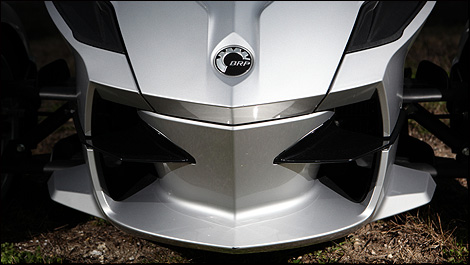On smooth city streets, the RT tootles along nicely, especially if you slow down enough in corners to eliminate lateral acceleration. i.e. when you drive it like more mature users are likely to. The RT keeps its composure as you move up to gentle touring speeds on a straight and smooth road, and lets you enjoy the fresh air and the scenery. Everyday bumps are absorbed easily through the softly sprung and softly dampened front suspension.
 |
| The front end, where the air management starts, designed to produce adequate cooling, not overheat the people, manage turbulence, and build a little downforce to contribute to stability at higher speeds. (Philippe Champoux/Moto123.com) |
Keeping up with the 115kph traffic on busy Interstate I95 for our commute from the hotel to Daytona was not as much fun, with the RT hunting from side to side as it went from the right to the left groove in the two right lanes, and the wind buffeting behind any kind of truck at over 100kph rose to intolerable levels.
I tried to minimize the turbulence by varying the height of the electrically adjustable windshield to no avail, as I suspect the sheer size of the frontal and side areas of the RT increase the nasty effects of side winds more than on machines with less frontal and side area. Proof of that was a back-to-back test with the sportier RS, which was much calmer in the same conditions on that cold morning. Between the buffeting and the left-right-left snaking movements as the machine hunted in its lane, I found the RT too much of a handful for long rides at Interstate speeds, unless, presumably, on an empty road and without any side wind.
Upon hearing about my concern, the good folks at BRP jacked up the front preload to the maximum and turned me loose. Low speed stability and the forgiving behaviour over bumps were hardly affected. On the Interstate, the RT hunted a lot less and the high frequency left-right wobble movements from the turbulence behind a truck had dropped to a more acceptable level.
Cornering the Spyder at anything above soft cruising pace is a bit of a production for the ordinary user, at least until a new reflex is learned, as the driver must hang on tight to fight off inertia from lateral acceleration (AKA “centrifugal force”). The passenger must either hang on to the driver or grab the handrails. In both cases, this can be hard work, good for upper-body fitness, but a bit of a hazard in emergency manoeuvring, say for an inattentive passenger.
When cornering harder, you can feel the VSS restricting torque as it senses that you are leaning too much in corner. Moving your bum way inside, like on a sport bike, reduces the lean angle and seemed to fool the VSS into letting you go a little quicker in the corner. But when the lean angle reaches its limit, the power cuts kick in just the same.
The low-pressure front tires bite into the pavement nicely when cornering even a little quicker, with the machine leaning over until it reaches the programmed limits and you feel the drop in engine power. I like to work for my fun, so sliding off the seat and using arm strength to get around corners and minimize lean is all good for me - as it is for Snowmobile or Quad riders, one of the target market for the Spyder. But I also like to ride quickly while expending less effort, which the lean of a two-wheeler makes easy, and more fun for my tastes.
Where does the Spyder RT fit in the adult toy continuum?
The Spyder is looking to create its own niche, and sales are great according to BRP, a closely held corporation that does not reveal financial results, so that real sales numbers are not available. Easing the permit requirements will certainly move sales up in the near- and mid-term.
As a confirmed bike guy, I am not tempted to turn to the Spyder, as I would rather go to a single-front-wheel trike, where the front suspension has more lateral “give” to cancel out irregularities, rather than the stiffer Spyder front end that reacts more to these irregularities and feels busier and less relaxing at higher speeds.
The RT’s personal comfort was way above average, solo performance was adequate, but high speed smoothness and stability are not up to par. The Spyder vehicle dynamics are complex, and BRP have done good work with Bosch to develop the VSS electronics that turn it into a safer machine for touring by everyday drivers. And more and more seem to be buying into the concept!

